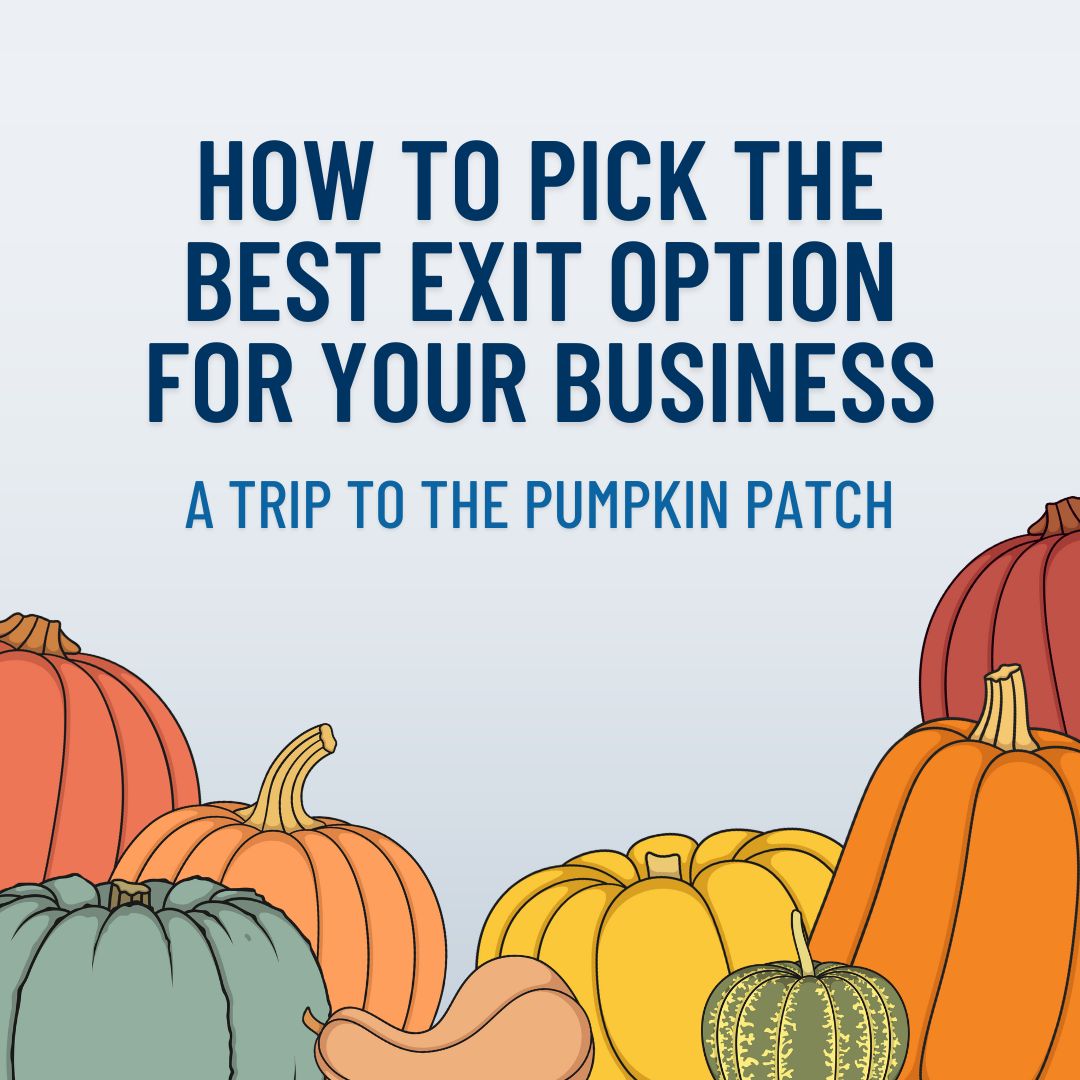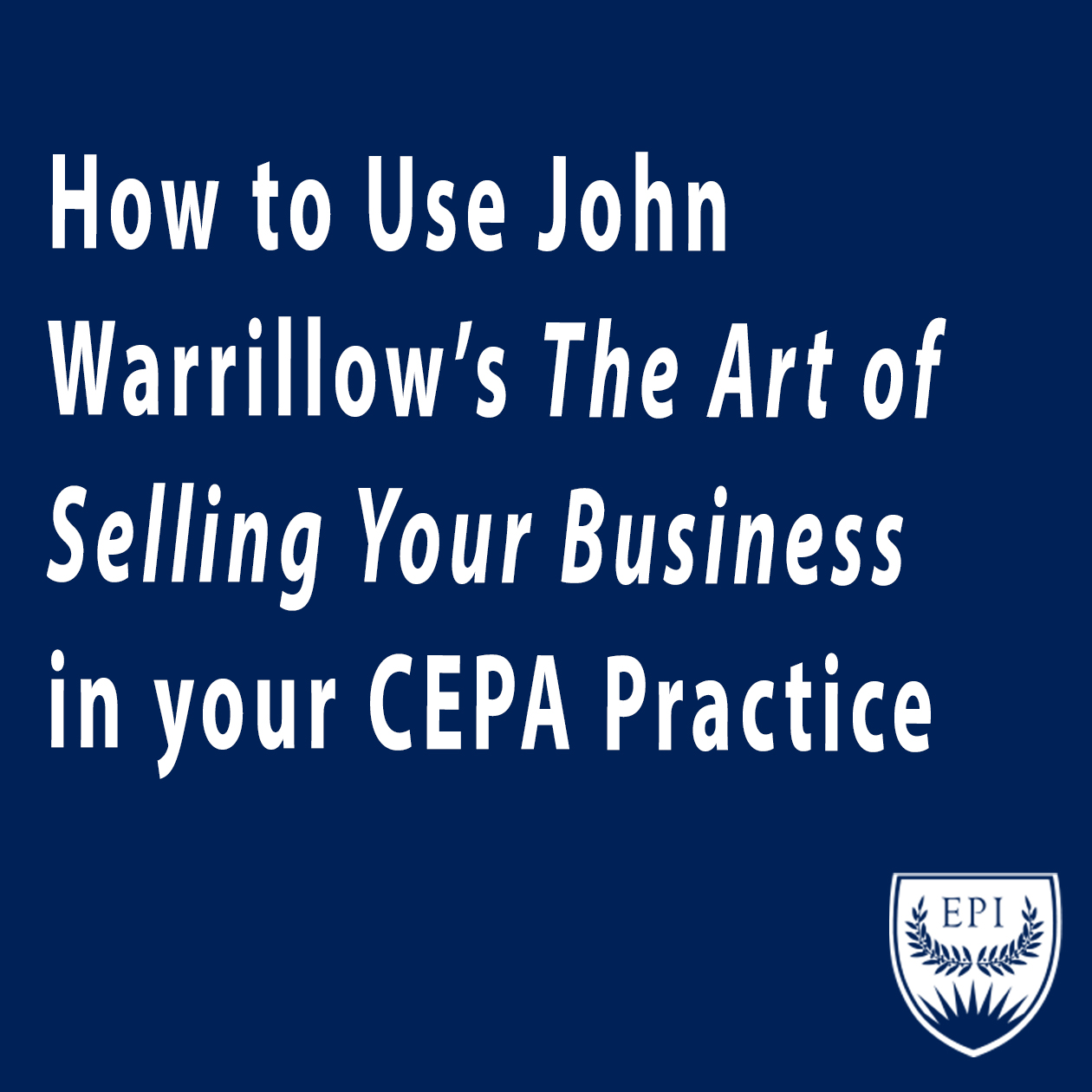
THE EXIT PLANNING BLOG
Keep up-to-date with exit planning, succession planning, industry trends, unique specialty insights, and useful content for professional advisors and business owners.
Share this
How to Pick the Best Exit Option for Your Business – A Trip to the Pumpkin Patch
by Colleen Kowalski on October 21, 2022

When walking through a pumpkin patch, many sizes, shapes, and colors of pumpkins fill the landscape. Each pumpkin has differing characteristics and specific uses. Some are perfect for carving into jack-o-lanterns, others make delicious pies and soups, and some are the perfect decorative touch for mantels and centerpieces.
As every pumpkin has its perfect use, every business has an exit option that is best for the business and owner.
Sale to Existing Partners

When planning your holiday decor, you decide you want to spruce up your mantel this year. You think a large pumpkin on either side of the fireplace would really tie the whole space together. The trouble is, you don’t know if you will be able to find two pumpkins that provide the similar look you are going for.
When strolling through the pumpkin patch, you notice two pumpkins that look nearly identical. They would be the perfect anchor pieces for your mantel as they would create a balanced and symmetrical image. As perfect as they are together, you notice that one of the pumpkins appears to be on its last leg so to speak. You begin reworking your design for one pumpkin instead of two and determine that it is just as strong.
Think of these two pumpkins as partners in a business. While they made a strong pair when working together to adorn the mantel, when separated, the staying power and appearance of the one pumpkin was just as effective after adjusting to the new look. In businesses with multiple owners or partners, transitioning the business from two partners to one can be one of the more seamless business exit options for the exiting owner.
According to EPI CEO, Christopher Snider in his book Walking to Destiny, in partner transitions, “the success is closely linked to the existence and quality of a buy-sell agreement.” Typically selling a business to existing partners is less disruptive, involves well-informed buyers, and is more planned and less expensive. However, sometimes in a sale to partners, the sale price could be lower than the market value, there can be conflict among numerous partners over superiority, and the possibility of competency gaps.
Intergenerational Transfer

During the month of October, families across the country will spend time carving jack-o-lanterns. Parents will instruct their children on knife safety, pattern making, and how to scoop out every last seed from the inside of their pumpkins. Front doors are adorned with jack-o-lanterns of all sizes and craftsmanship on Halloween. By educating the kids from an early age, each year their work gets cleaner, their designs more intricate, and the appreciation of their work grows.
Similar education opportunities should be given to family members in a family-owned business before you exit. According to Walking to Destiny, about 50% of business owners want to transition their business to family members, however, only 30% successfully do so. By educating family members on the ins and outs of your business you not only have a better-equipped successor but you know if your family member is actually interested in taking over the business in the future.
Some of the benefits of an intergenerational transfer are the preservation of the family business legacy, more control over the transaction, a lower cost to sell, and less disruption in the business after exit. However, family dynamics can cause a roadblock in the transition. Additionally, some family business successors have illiquid funds or lack the funds needed to purchase the business outright, leading to a longer transaction and transition period.
ESOP

First, let us provide you with a fun fact. The pumpkins covered in knots and bumps are called Knucklehead pumpkins. This incredible name is something not many people know about, much like Employee Stock Ownership Plans (ESOPs). A knucklehead pumpkin would not be a knucklehead pumpkin without each and every knot, bump, and lump on its surface. Similarly, if not for each employee, a business would not be a success.
In an Employee Stock Ownership Plan, the company uses borrowed funds to acquire shares from the owner and contribute the shares to a trust on behalf of the employees. As some may see the knots on the pumpkin as negatives, there are some considerations in ESOPs that can be difficult for exiting owners. Organizing an ESOP is expensive and can be very complicated. It requires securities registration exemption and is generally only suitable for owners who wish to exit gradually over time. Some owners also can be compelled to buy back shares from departing employees.
However, ESOPs provide great employee benefits as they are all part owners of the business if they choose to buy into the ESOP. Additionally, taxable gain on the shares sold to the ESOP by the owner may be deferred and the shares purchased by employees are done with pre-tax dollars.
Orderly Liquidation

Every type of pumpkin serves its own purpose. Whether as decoration or to bake into a pie, there is a use for every part of a pumpkin. While sugar pumpkins can make fine decorations, their true value lies in their ability to create the perfect creamy pumpkin pie. The seeds can be roasted, the inside of the pumpkin is baked to perfection, and an entirely new item is formed. While fine in its original state, when separated and used in multiple ways, the value of the sugar pumpkin grows.
If you are planning to exit your business, one of the options is an Orderly Liquidation. In this exit option, the business is shut down through a simple and quick process. This makes sense if the asset values exceed the ability of the business to produce the income required to support investment. If you own a large property and machinery it may be more valuable to sell them as individual components than as part of the business.
This can be a good option if asset division produces more value than a complete sale of the business. This could be less expensive than other exit options however, there is no guarantee that a buyer will purchase the individual components. Additionally, this would have a negative impact on the employees and possibly the surrounding community that relied on the jobs from the business.
Learn more about exit options at our 2023 Exit Planning Summit this May in Scottsdale, Arizona. We will have a breakout panel of experts discussing exit options and strategies. Register for the Summit here.
Follow our socials for more exit planning content and strategies.
Share this
- Blog (541)
- CEPA (417)
- exit planning (248)
- CEPA community (186)
- Business Owner (168)
- Exit Planning Summit (94)
- EPI Chapter Network (88)
- Value Acceleration Methodology (78)
- Exit Planning Partner Network (76)
- EPI Announcement (49)
- Content (48)
- Webinars (37)
- Excellence in Exit Planning Awards (32)
- Marketing (30)
- 2024 Exit Planning Summit (28)
- 5 Stages of Value Maturity (26)
- Books (24)
- EPI Academy (22)
- Exit Planning Teams (22)
- EPI Team (21)
- Leadership (21)
- 2023 Exit Planning Summit (20)
- family business (19)
- women in business (19)
- Intangible Capital (18)
- Exit Options (17)
- Black Friday (16)
- CPA (15)
- Walking to Destiny (15)
- State of Owner Readiness (14)
- Chapters (13)
- Chris Snider (12)
- National Accounts (12)
- Small business (12)
- charitable intent (12)
- personal planning (12)
- Financial Advisors (11)
- Season of Deals (9)
- 5 Ds (8)
- About us (8)
- Podcast (8)
- Insiders Bash (7)
- Scott Snider (7)
- Christmas (6)
- Exit Planning Content Library (6)
- Case Studies (5)
- Owner Roundtables (5)
- Value Advisors (5)
- financial planning (5)
- Awards (4)
- Circle of Excellence (4)
- Exit & Succession (4)
- Five Ds (4)
- Three Legs of the Stool (4)
- executive training (4)
- Owners Forum (3)
- author (3)
- forbes (3)
- DriveValue (2)
- EPI Thought Leadership Council (2)
- Exit Is Now Podcast (2)
- Peter Christman (2)
- Veteran (2)
- Whitepapers (2)
- Business Owners Forum (1)
- SOOR (1)
- business consultants (1)






